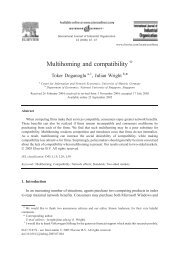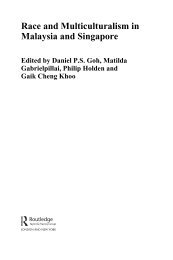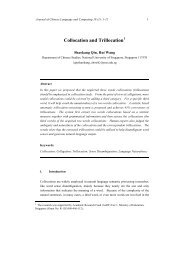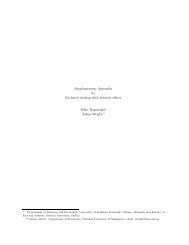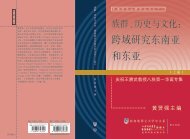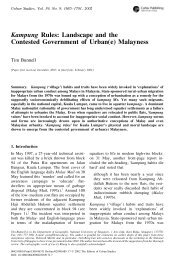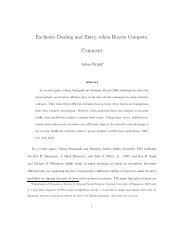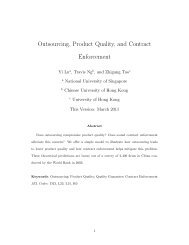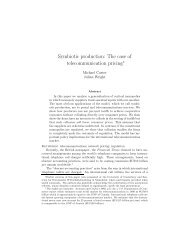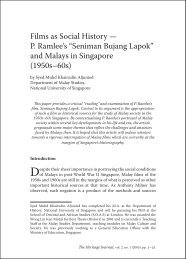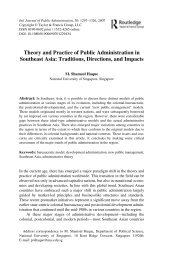Ummi's Obedience in Marriage: A Critical Study of ... - NUS - Home
Ummi's Obedience in Marriage: A Critical Study of ... - NUS - Home
Ummi's Obedience in Marriage: A Critical Study of ... - NUS - Home
Create successful ePaper yourself
Turn your PDF publications into a flip-book with our unique Google optimized e-Paper software.
KEMA<strong>NUS</strong>IAAN Vol. 19, No. 2, (2012), 79–103<strong>Ummi's</strong> <strong>Obedience</strong> <strong>in</strong> <strong>Marriage</strong>: A <strong>Critical</strong> <strong>Study</strong> <strong>of</strong> Shahnon'sUmmi & Abang SyeikhulJYH WEE SEWNational University <strong>of</strong> S<strong>in</strong>gapore, S<strong>in</strong>gaporeclssjw@nus.edu.sgAbstract. Malay literature can be a way by which Malay social issues areexam<strong>in</strong>ed if <strong>in</strong>deed one subscribes to the Art for the Society movement asadvocated by the Association <strong>of</strong> Malay Writers. Shahnon Ahmad's novel, Ummi& Abang Syeikhul (1992) is a relevant work with which one can contextualise thecontroversy that the Obedient Wives Club (Kelab Isteri Taat a.k.a Kelab TaatSuami) generated upon its establishment <strong>in</strong> Rawang, Selangor on 4th June 2011.(The sett<strong>in</strong>g up <strong>of</strong> a S<strong>in</strong>gapore branch <strong>of</strong> Kelab Isteri Taat followed <strong>in</strong> July 2011)The club's proclamation that social ills such as prostitution and divorce could beresolved with a wife keep<strong>in</strong>g her husband happy through obedient submission <strong>in</strong>the bedroom came across as suspiciously provocative. A reflective <strong>in</strong>terpretationto the claim is possible with Shahnon's novel, which explores polygamous issuesthrough the eyes <strong>of</strong> Ummi. As the third wife, <strong>Ummi's</strong> efforts <strong>in</strong> appeas<strong>in</strong>gSyeikhul's <strong>in</strong>satiable sexual desires, address the conundrum <strong>of</strong> obedience <strong>in</strong> aMalay marriage. The complex emotions underly<strong>in</strong>g <strong>Ummi's</strong> marital subjugation,mental conflicts and cooperative collaboration with Syeikhul's other wivesillustrate that an obedient wife is <strong>in</strong> a constant battle with contradictory<strong>in</strong>trapersonal feel<strong>in</strong>gs despite a resignation to her own fate. This analysis <strong>of</strong>fers acultural-literary perspective <strong>of</strong> marital obedience <strong>in</strong> the <strong>in</strong>terest <strong>of</strong> utilis<strong>in</strong>gliterature as an empower<strong>in</strong>g tool towards the betterment <strong>of</strong> the society.Keywords and phrases: modern Malay literature, marital obedience, novel associal cognition, Shahnon AhmadIntroductionThis discussion beg<strong>in</strong>s with a short summary <strong>of</strong> the plot found <strong>in</strong> the novel andthis will be followed by a review <strong>of</strong> select local and foreign contemporaryModern Malay Literature scholars' current analyses on Shahnon's novel. Thisscrut<strong>in</strong>y reveals that the emotional suppression <strong>of</strong> an obedient spouse, as narrated<strong>in</strong> Ummi & Abang 1 Syeikhul, is an aspect not highlighted <strong>in</strong> the literary analyses.Explor<strong>in</strong>g the emotional complex <strong>of</strong> Ummi as an obedient wife liv<strong>in</strong>g <strong>in</strong> anIslamic polygamous household generates <strong>in</strong>sights on what be<strong>in</strong>g "obedient"actually entails, with marital obedience be<strong>in</strong>g a slippery yet laudable concept <strong>in</strong> aMalay marriages.© Penerbit Universiti Sa<strong>in</strong>s Malaysia, 2012
80 Jyh Wee SewFram<strong>in</strong>g the emotional tribulations <strong>of</strong> an obedient female spouse <strong>in</strong> a culturalliterarydiscourse augments an area excluded from the Obedient Wives Club's(OWC) rhetoric. In campaign<strong>in</strong>g for the full submission <strong>of</strong> wives' for theenhancement <strong>of</strong> their husbands' sexual experience, the OWC subscribes to astructural view <strong>of</strong> marriage that is biased towards the carnal desires <strong>of</strong> the malespouse. This structural fallacy <strong>in</strong> the OWC's viewpo<strong>in</strong>t became more pronouncedwith the publication <strong>of</strong> Islamic Sex <strong>in</strong> October 2011 suggest<strong>in</strong>g that jo<strong>in</strong>t sexualactivities <strong>of</strong> more than two persons was a means through which a highersatisfaction <strong>in</strong> one's marriage could be atta<strong>in</strong>ed (Sew, 2011a). This discussion isan <strong>in</strong>vestigation <strong>of</strong> <strong>Ummi's</strong> emotional states while play<strong>in</strong>g the role <strong>of</strong> an obedientwife. We make it clear that it is every married couple's own decision whether ornot to be "obedient". Nonetheless, the emotional well-be<strong>in</strong>g <strong>in</strong> play<strong>in</strong>g anobedient spouse should not be ignored, not least because the concept <strong>of</strong> maritalobedience is a sensitive component and yet important <strong>in</strong> ma<strong>in</strong>ta<strong>in</strong><strong>in</strong>g aharmonious marriage.The PlotA brief summary here is especially relevant for readers who either do not readMalay novels, or are unaware <strong>of</strong> Shahnon's novel's place <strong>in</strong> the Malay literaryworld. The ideational sketch provides the cognitive foundation on which theappreciation and understand<strong>in</strong>g <strong>of</strong> subsequent discussions and diagrammatic<strong>in</strong>terpretation are based. As a follow-up, readers f<strong>in</strong>d<strong>in</strong>g the anecdotal<strong>in</strong>troduction appeal<strong>in</strong>g may construct their own op<strong>in</strong>ions on obedient maritalrelationships.Shahnon Ahmad, who received the Malaysian National Literary Award <strong>in</strong> 1982,portrays Ummi as the third wife <strong>of</strong> Abang Syeikhul <strong>in</strong> Ummi & Abang Syeikhul.In the first chapter, Ummi is portrayed as a blissful young wife, smil<strong>in</strong>g <strong>in</strong> hersleep whilst imag<strong>in</strong><strong>in</strong>g that she was <strong>in</strong> a position <strong>of</strong> superiority as the preferredwoman <strong>in</strong> Syeikhul's life. As the youngest wife <strong>of</strong> Syeikhul, Ummi is confidentthat she is capable <strong>of</strong> banish<strong>in</strong>g the lusty beast with<strong>in</strong> her husband, so enabl<strong>in</strong>gSyeikhul to focus on his missionary work. In her mus<strong>in</strong>g, she credits his first andthe second wives, Jawaher and Siti Hawa, for teach<strong>in</strong>g her about the varioustechniques preferred by Syeikhul.In the second chapter, Ummi remembers her experience as a newlywed andJawaher's advice on endur<strong>in</strong>g Syeikhul's desires and bedroom antics.Furthermore, she recalls Syeikhul's <strong>in</strong>structions that be<strong>in</strong>g discreet should rema<strong>in</strong>the norm <strong>in</strong> her public conduct although she should have no qualms aboutbehav<strong>in</strong>g shamelessly with Syeikhul <strong>in</strong> the privacy <strong>of</strong> her bedroom. Ummi seemscontent <strong>in</strong> replay<strong>in</strong>g her husband's words that there was noth<strong>in</strong>g dirty between
<strong>Ummi's</strong> <strong>Obedience</strong> <strong>in</strong> <strong>Marriage</strong> 81husband and wife <strong>in</strong> her m<strong>in</strong>d. However, her glee <strong>of</strong> believ<strong>in</strong>g that she was trulythe beloved wife beg<strong>in</strong>s to wane when Syeikhul spends extra nights with SitiHawa more frequently. Thereafter, imag<strong>in</strong><strong>in</strong>g and loath<strong>in</strong>g what takes place <strong>in</strong>Siti Hawa's bedroom becomes <strong>Ummi's</strong> lonely nocturnal preoccupation.In the third chapter, Ummi becomes even more restless as her turn with herhusband is denied once aga<strong>in</strong>. She beg<strong>in</strong>s to show signs <strong>of</strong> madness by throw<strong>in</strong>gherself on to the mattress <strong>in</strong> the darkness <strong>of</strong> her abode, kick<strong>in</strong>g the air andfight<strong>in</strong>g the halluc<strong>in</strong>ation <strong>of</strong> two ghostly figures, resembl<strong>in</strong>g her husband and SitiHawa, hugg<strong>in</strong>g each other. The lonely nights, haunted with illusionary imagescoupl<strong>in</strong>g and laugh<strong>in</strong>g, repeatedly erodes the <strong>Ummi's</strong> sanity. Although each wife<strong>in</strong> a polygamous Islamic family is supposed to be accorded her turn with herhusband equally, the husband may request that one wife forgoes her turn, thuslett<strong>in</strong>g him spend the night with another wife <strong>of</strong> his choice and fancy.In the fifth chapter, the three wives meet for a lunch at Jawaher's place dur<strong>in</strong>gwhich the absent-m<strong>in</strong>ded husband checks out the person he would spend thenight with. After several turns <strong>of</strong> question<strong>in</strong>g, Ummi hastily po<strong>in</strong>ts out that theperson was Jawaher. At the end <strong>of</strong> the afternoon meal, however, a suspiciouswhisper from Jawaher to Syeikhul becomes her sacrificial <strong>of</strong>fer for Syeikhul toshare the night with Ummi.In the seventh chapter, Ummi waits impatiently for her husband who cont<strong>in</strong>ues topreach to a group <strong>of</strong> followers at home. The thought <strong>of</strong> tear<strong>in</strong>g the curta<strong>in</strong> thatshields herself from the audience and chas<strong>in</strong>g away the crowd cont<strong>in</strong>ually plays<strong>in</strong> <strong>Ummi's</strong> m<strong>in</strong>d. However, the eventual experience was dismay<strong>in</strong>g, lukewarmand fell far short <strong>of</strong> what she had come to expect <strong>of</strong> Syeikhul.<strong>Ummi's</strong> bewilderment was met with Syeikhul's <strong>in</strong>tention to take a fourth wife,which was later made known to the entire household <strong>in</strong> the eighth chapter.Interest<strong>in</strong>gly, all the wives give their bless<strong>in</strong>gs to him and he subsequently cries<strong>in</strong>cessantly as a gesture <strong>of</strong> appreciation. Each <strong>of</strong> the three wives agree to theconcession <strong>of</strong> either two or three nights, thus lett<strong>in</strong>g Syeikhul spend more timewith the <strong>in</strong>com<strong>in</strong>g fourth wife – one deemed necessary for Syeikhul to susta<strong>in</strong> hismissionary work.Previous treatment <strong>of</strong> UmmiCurrent scholarly debates on Ummi & Abang Syeikhul exam<strong>in</strong>e zoom <strong>in</strong> on thecreative and/or erotic approach that Shahnon deploys <strong>in</strong> tackl<strong>in</strong>g the genre <strong>of</strong>Islamic literature. The reviews from local and foreign scholars <strong>in</strong>dicate thatShahnon's work attracts an academic follow<strong>in</strong>g among literary scholars. In hisread<strong>in</strong>g, Harry Avel<strong>in</strong>g provides a summary <strong>of</strong> the novel before relat<strong>in</strong>g it to the
82 Jyh Wee Sewbanned Darul Arqam, a self-styled bus<strong>in</strong>ess empire that started as a religiousstudy group led by Ustaz Ashaari:The plot is almost entirely based on a description <strong>of</strong> <strong>Ummi's</strong>wait<strong>in</strong>g her "turn" to spend the night with her husband, AbangSyeikhul (Ashaari 2 was commonly known as Syeikhul Arqam,the Leader <strong>of</strong> Darul Arqam). We are given <strong>in</strong> considerable detailher endless sexual fantasies about her past nights with him, andher <strong>in</strong>tense frustration at the cont<strong>in</strong>ual postponement <strong>of</strong> her unionwith him. From be<strong>in</strong>g his fourth [sic] wife at the end <strong>of</strong> the novel… (Avel<strong>in</strong>g 2000, 212).Avel<strong>in</strong>g concludes that Ummi might have achieved significant spirituality fromher divorce with Syeikhul if the goal <strong>of</strong> Islamic piety is regarded as the ultimatereason. Similar to Avel<strong>in</strong>g's l<strong>in</strong>e <strong>of</strong> thought, a peculiar reason<strong>in</strong>g was circulatedamong Kedah Muslim men for the uphold<strong>in</strong>g <strong>of</strong> polygamy, which later become apopular practice <strong>of</strong> Al-Arqam. Fem<strong>in</strong>ist anthropologists f<strong>in</strong>d it perplex<strong>in</strong>g thatsome Malay women would share their husband for the chance to enter heaven:… stories <strong>of</strong> women go<strong>in</strong>g straight to heaven, if they allowedtheir husbands to marry another were rampant at the peak <strong>of</strong> thenow banned Al-Arqam movement <strong>in</strong> Malaysia, <strong>in</strong> the late 1980sand early 1990s and speaks a lot about the psychologicaldependency <strong>of</strong> women on spiritual (pahla) returns <strong>in</strong> this modernage when most good th<strong>in</strong>gs are measured <strong>in</strong> terms <strong>of</strong> economicwealth (Karim 2002, 113).In a separate study, Mohd Zariat (2008) compared Shahnon's Tok Guru (1988)with Ummi & Abang Syeikhul through the lenses <strong>of</strong> Pujangga Baru (PB), orIslamic Literary Criticism. The foundation <strong>of</strong> PB is based on taklif, that is to say,the connection between man and primordial covenant with Islam as its conceptualunderp<strong>in</strong>n<strong>in</strong>g. All the novelists, accord<strong>in</strong>g to PB, have an <strong>in</strong>cl<strong>in</strong>ation to set arighteous agenda to dissem<strong>in</strong>ate knowledge sanctioned by human nature. As avehicle <strong>of</strong> truth, the narrative axis exploits its narrative devices with<strong>in</strong> thenarrative space <strong>of</strong> a novel to guide the readers towards primary knowledge oradab. Consequently, PB is <strong>in</strong> essence part <strong>of</strong> the school <strong>of</strong> didactic method.Accord<strong>in</strong>g to Mohd Zariat (2008), the narrative axis <strong>of</strong> Ummi & Abang Syeikhulsituates Malay polygamy <strong>in</strong> two k<strong>in</strong>ds <strong>of</strong> distortion, namely the <strong>in</strong>terpretation andthe practice <strong>of</strong> polygamy, with the novel be<strong>in</strong>g perceived as a distortion <strong>of</strong>polygamy <strong>in</strong> favour <strong>of</strong> the perpetrator's lust. Mohd Zariat claims that sexual anderotic references have filled most <strong>of</strong> the chapters <strong>in</strong> the plot to such an extent thathe disagreed with Harry Avel<strong>in</strong>g's analysis that Ummi could ever atta<strong>in</strong> spiritualaccomplishment follow<strong>in</strong>g her divorce from Syeikhul. Alas, moral-based
<strong>Ummi's</strong> <strong>Obedience</strong> <strong>in</strong> <strong>Marriage</strong> 83criticisms shuts the door on experiential reason<strong>in</strong>g that the human m<strong>in</strong>d iscapable <strong>of</strong>. The feel<strong>in</strong>gs lead<strong>in</strong>g to the actions <strong>of</strong> the characters <strong>in</strong> the plot, whichare relevant as a guide to understand<strong>in</strong>g human behaviour, escapes the puriststandpo<strong>in</strong>t <strong>of</strong> PB. It is arguable that the actions <strong>of</strong> everyday liv<strong>in</strong>g, eitherconsciously or unconsciously executed, are very much emotionally-basedperformances (Karim 1990; 2002, Roach 2007, Sew 2009).In a different analysis, Ooi (2005) compares the plots <strong>of</strong> Ummi and AbangSyeikhul and Tok Guru and concludes that Ummi was exploited by Syeikhul. Thedelay<strong>in</strong>g <strong>of</strong> <strong>Ummi's</strong> turn, thus lead<strong>in</strong>g to <strong>Ummi's</strong> "<strong>in</strong>sanity", shows that Ummiwas at her husband's whim and fancy (see below). In detailed descriptions, Ooiillustrates that Syeikhul exploits Ummi as an object <strong>of</strong> pleasure. Fall<strong>in</strong>g prey toher husband's manipulation and distortion <strong>of</strong> the holy verse Surah Al-Baqarah,Ummi relents and consents to certa<strong>in</strong> <strong>in</strong>appropriate sexual activities (see alsoAvel<strong>in</strong>g 2000, 213). Similar to Avel<strong>in</strong>g's position, Ooi believes that Ummi’sseparation from Syeikhul permits her to commit herself to God.Extend<strong>in</strong>g Ooi's analysis, we see <strong>Ummi's</strong> helplessness as a creation <strong>of</strong> unilateralbil<strong>in</strong>gual trickery. Cit<strong>in</strong>g holy phrases from Al-Quran, Syeikhul conv<strong>in</strong>ces Ummithat it was the wife's rightful duty to fulfil her husband's sexual needs. Ooi'sanalysis, however, renders Ummi a lifeless object, thereby ignor<strong>in</strong>g her long<strong>in</strong>gfor Syeikhul to consummate the marital union accord<strong>in</strong>g to her designated slots.The term exploitation thus constitutes a unilateral view. <strong>Ummi's</strong> desires as ayoung wife married to an experienced husband are thrown out <strong>of</strong> Ooi's analyticalw<strong>in</strong>dow. The thematic dissection <strong>of</strong> the plot us<strong>in</strong>g the "what happened" and "whodid what to who" lenses brushes aside <strong>Ummi's</strong> emotional needs which <strong>in</strong>cludeenjoy<strong>in</strong>g holy sexual acts. After all, Ummi is told that she makes immensecontributions <strong>in</strong> susta<strong>in</strong><strong>in</strong>g Syeikhul's strength by submitt<strong>in</strong>g herself to him.Moreover, Ummi is made to believe that her submission would br<strong>in</strong>g about areward<strong>in</strong>g afterlife.This husband-oriented <strong>in</strong>timacy resonates well with many Malay women <strong>in</strong> theSoutheast Asian region. Indeed, the Obedient Wives Club, set up <strong>in</strong> the regions <strong>of</strong>East and Southeast Asia, operates by this <strong>in</strong>terpersonal pr<strong>in</strong>ciple (see below).That Malay men are now allowed to apply for a fasakh divorce <strong>in</strong> the NewEnactment <strong>of</strong> Syariah (the Islamic law) <strong>in</strong> Malaysia is a prime example <strong>of</strong> ahusband-oriented marital relationship <strong>in</strong> the Malay world. As expounded <strong>in</strong>Maznah Mohamad (2011), a new form <strong>of</strong> mascul<strong>in</strong>ity is be<strong>in</strong>g bestowed uponMalay men with the <strong>in</strong>stitutionalis<strong>in</strong>g <strong>of</strong> the rights to polygamy, unconditionalcustody <strong>of</strong> children and unilateral divorce <strong>in</strong> the New Enactment.Arguably, <strong>in</strong>terpersonal sexual experience, which is part <strong>of</strong> a satisfy<strong>in</strong>g adult life,becomes the (<strong>in</strong>itial) basis to the psyche <strong>of</strong> (American) women, either
84 Jyh Wee Sewconsciously or subconsciously. A notable example came from Eve Ensler whoshared her experience from a workshop that <strong>in</strong>voked a self-realisation <strong>of</strong> herpsyche (2001, 48):… on our mats, f<strong>in</strong>d<strong>in</strong>g our spots, our locus, our reason, and Idon’t know why, but I started cry<strong>in</strong>g … Maybe it was know<strong>in</strong>gthat I had to give up the fantasy, the enormous life-consum<strong>in</strong>gfantasy that someone or someth<strong>in</strong>g was go<strong>in</strong>g to do this forme−the fantasy that someone was com<strong>in</strong>g to lead my life, tochoose direction, to give me orgasms.Thus far, the common criticism levelled aga<strong>in</strong>st Shahnon's novel <strong>in</strong>dicates thatthere is a great deal <strong>of</strong> moral panic. A failure to preach virtuosity explicitly,accord<strong>in</strong>g to Islamic virtues, <strong>of</strong>ten becomes the criterion with which to evaluateShanon's novel. Unsurpris<strong>in</strong>gly, Ummi & Abang Syeikhul is regarded as anunworthy read and is considered to be an appall<strong>in</strong>g representation <strong>of</strong> a properIslamic literature. 3 In this ve<strong>in</strong>, a reader considered the repeated uses <strong>of</strong> similessuch as lions and tigers as metaphors <strong>of</strong> the religious leader's sexual aggression as<strong>in</strong>dicators <strong>of</strong> political <strong>in</strong>correctness <strong>in</strong> modern Malay literature (Washima, 2006).The explicit sexual references <strong>in</strong> the plot was the ma<strong>in</strong> reason beh<strong>in</strong>d thecriticisms levelled at this novel despite Ummi atta<strong>in</strong><strong>in</strong>g a higher level <strong>of</strong>spirituality after the eschew<strong>in</strong>g <strong>of</strong> sexual fantasies and practices.The negative attitude toward eroticism suggests that high moral fibre isconsidered to be the ma<strong>in</strong> <strong>in</strong>gredient for a good novel. Contrary to the op<strong>in</strong>ionthat highbrow literature should not conta<strong>in</strong> erotic content, Hooker (2000)elucidated that sex is not a taboo subject <strong>in</strong> Malay fiction. We would argue thatthe sexual exploitation <strong>of</strong> the third wife is an attempt to represent the mutedgroup that is, more <strong>of</strong>ten than not, ostracised <strong>in</strong> the society. The novel SalamMaria, for example, demonstrates that voyeuristic imag<strong>in</strong>ation and dialogueexchanges connotative <strong>of</strong> sexual activities are <strong>of</strong>ten hurled at s<strong>in</strong>gle Malaywomen, which only become obvious follow<strong>in</strong>g critical and serious ponder<strong>in</strong>g.Serious readers <strong>in</strong> Shahnon Ahmad's sense (2011) should be able to comb abor<strong>in</strong>g plot with a critical sieve. For example, should Syeikhul's s<strong>in</strong>gularlyderived <strong>in</strong>terpretations <strong>of</strong> holy verses be counterchecked? 4 Also, noth<strong>in</strong>g is said<strong>of</strong> Syeikhul's contribution <strong>in</strong> releas<strong>in</strong>g Ummi from the decadent moral practice <strong>of</strong><strong>in</strong>dulg<strong>in</strong>g <strong>in</strong> sex follow<strong>in</strong>g the divorce.In contrast to the criticism directed at the erotic content, Abdul Rahman Napiah(2010) explicated that the sexual references are generated from <strong>Ummi's</strong>subconscious and conscious thoughts as a foreground towards a deeperunderstand<strong>in</strong>g <strong>of</strong> the novel. Abdul Rahman Napiah notes that the strength <strong>of</strong> awife's belief <strong>in</strong> God follow<strong>in</strong>g her consent to a divorce is an important subplot <strong>in</strong>
<strong>Ummi's</strong> <strong>Obedience</strong> <strong>in</strong> <strong>Marriage</strong> 85Shahnon's version <strong>of</strong> Islamic literature, Penceraian membawa nikmat, keranac<strong>in</strong>ta yang hendak dicurahkan kepada seseorang yang telah hilang itu akanberkumpul menambah keimanan…[Divorce br<strong>in</strong>gs about fulfilment, because lovethat was <strong>in</strong>tended for a person who becomes no longer available can beaccumulated towards religious atta<strong>in</strong>ment, my translation] (Abdul RahmanNapiah 2010, 40).While it is possible for the newly-s<strong>in</strong>gle to acquire a transcendental self,becom<strong>in</strong>g s<strong>in</strong>gle aga<strong>in</strong> may also <strong>in</strong>cur the implication <strong>of</strong> be<strong>in</strong>g viewed as sexuallyavailable. A researcher shared her experience <strong>of</strong> female s<strong>in</strong>glehood, which is ak<strong>in</strong>to be<strong>in</strong>g readily available for sexual advancement, when she was advised to staywith a Malay family to avoid unfavourable attention (Ong, 1995). The underly<strong>in</strong>gmessage is that without the polic<strong>in</strong>g <strong>of</strong> men <strong>in</strong> the Malay village, women could,and would, be perceived as sexually available. The experience <strong>of</strong> the protagonistMaria Zaitun <strong>in</strong> Salam Maria (Wong 2011a) <strong>in</strong> be<strong>in</strong>g subjected to the sexualfantasies <strong>of</strong> laymen, sexual proposition<strong>in</strong>g <strong>of</strong> a bus<strong>in</strong>essman, and <strong>in</strong> fac<strong>in</strong>gaccusations about partak<strong>in</strong>g <strong>in</strong> sexually immoral behaviour by other marriedwomen, could not make the po<strong>in</strong>t any clearer. 5Shahnon's brilliant tell<strong>in</strong>g <strong>of</strong> so-called leaders' sexual desires and practicescompels the readers to exam<strong>in</strong>e the conduct <strong>of</strong> Islamic leaders. Syeikhul's<strong>in</strong>cl<strong>in</strong>ation to marry and then divorce his wives after a period <strong>of</strong> time for thepurpose <strong>of</strong> marry<strong>in</strong>g other, younger, women provides readers with much food forthought. The plot conta<strong>in</strong>s many antitheses to the virtues preached <strong>in</strong> Islam,which are relatable to the current world, especially <strong>in</strong> Southeast Asia. Themismatch <strong>in</strong> Syeikhul's action vis a vis his preach<strong>in</strong>g is <strong>in</strong>strumental forgenerat<strong>in</strong>g new syntheses to cross-exam<strong>in</strong>e spoken words with actual deeds <strong>of</strong>the local leaders.The role <strong>of</strong> Malay literature as a tool to address social issues harks back to theliterary movement <strong>of</strong> the 50s, better known as ASAS 50. Hooker (2000) expla<strong>in</strong>sthat ASAS 50 comprises <strong>of</strong> Malay writers promot<strong>in</strong>g the cause <strong>of</strong> art for thesociety, <strong>in</strong> particular the oppressed, by speak<strong>in</strong>g on their behalf. The notion <strong>of</strong>rakyat bears a special significance as the concept refers to Malays who are be<strong>in</strong>goppressed by other Malays (Ahmad Fauzi Abdul Hamid 2011). It is timely to<strong>in</strong>voke the constructed experiences <strong>in</strong> Shahnon's novel as an alternative foraddress<strong>in</strong>g the practice <strong>of</strong> Muslim wifely submission to their husbands. As acritique <strong>of</strong> gender exploitation, the novel is a vehicle <strong>of</strong> social development forthe rakyat or the people.<strong>Ummi's</strong> voice as the narrator constitutes the ma<strong>in</strong> narrative strategy <strong>in</strong> the noveland it is through the eyes and voice <strong>of</strong> the third wife that the story <strong>of</strong> affectionand disorientation takes shape. This strategy creates an opportunity to exam<strong>in</strong>e
86 Jyh Wee Sewthe emotional complexity underp<strong>in</strong>n<strong>in</strong>g <strong>Ummi's</strong> well-be<strong>in</strong>g – namely a dividedpsyche <strong>of</strong> a confused and crippled persona masquerad<strong>in</strong>g as a cooperative wife.This emotional turmoil stems from the pragmatic-cum-competitive self as, amongother th<strong>in</strong>gs, Ummi harbours hopes that Jawaher, the first and oldest wife, wouldbe divorced by Abang Syeikhul:Terasa benar untuk mengejutkan Abang Syeikhul. Kalau hendakceraikan Kak Jawaher kerana Kak Jawaher tak mampu lagimemberi sumbangan yang berkesan, katakanlah (p. 65).Really feel like wak<strong>in</strong>g up Abang Syeikhul. If he wants to divorcesister Jawaher because sister Jawaher could not <strong>of</strong>fer effectivecontribution, do say so (p. 65, Author's translation).<strong>Ummi's</strong> egoistic self is dented by a series <strong>of</strong> disappo<strong>in</strong>tments which beg<strong>in</strong>s withSyeikhul spend<strong>in</strong>g successive nights with Siti Hawa, the older second wife.<strong>Ummi's</strong> sanity was affected, not least because the recurrent denial <strong>of</strong> her turns tospend the night delivered heavy blows on <strong>Ummi's</strong> pride:… dan Ummi cuba mengusirkan wajah-wajah itu jauh-jauhdengan pancutan ludahnya … Wajah yang dijerkah menjadibertambah galak … terus mendekati Ummi dengan ejekan …Ummi cuba mencapai wajah-wajah dengan tangannya yangpanjang tetapi malam itu tangan Ummi tiba-tiba terasa begitukontot dan pendek … Ummi cuba mengangkat kedua belahkak<strong>in</strong>ya yang terasa masih bertenaga … Segala tenaga tiba-tibaterlucut dari jasad Ummi dan … tubuh la<strong>in</strong> yang dikenali … itusebagai tubuh hak punya Kak Siti. Malam itu sebenarnya bukanhak Ummi (p. 35).… and Ummi tried to chase the imag<strong>in</strong>ary faces far away with aspray <strong>of</strong> spit…The faces that she yelled at became more active …clos<strong>in</strong>g <strong>in</strong> to tease Ummi … Ummi tried to grab the faces with herlong hands but that night her hands suddenly became stout andshort …Ummi raised her both legs, which were still strong … Allthe energy suddenly dissipated from <strong>Ummi's</strong> body and one <strong>of</strong> therecognisable figures …was that <strong>of</strong> sister Siti. That night wasactually not for Ummi to own (p. 35, Author's translation).A close read<strong>in</strong>g <strong>of</strong> Shahnon's novel shows that the silent yet <strong>in</strong>tense suffer<strong>in</strong>gs <strong>of</strong>the weaker sex/gender with<strong>in</strong> the patriarchal system. The narrative captures thes<strong>of</strong>t yet damag<strong>in</strong>g impact <strong>of</strong> oppression which is capable <strong>of</strong> penetrat<strong>in</strong>g deeply<strong>in</strong>to the sanity <strong>of</strong> the victims' m<strong>in</strong>d. Morality, or the lack <strong>of</strong> it, <strong>in</strong> the plot is a
<strong>Ummi's</strong> <strong>Obedience</strong> <strong>in</strong> <strong>Marriage</strong> 87thought-provok<strong>in</strong>g theme which encourages the readers to question the leaders'exploitation <strong>of</strong> their hegemony.Why was Ummi abandoned by Syeikhul even after ma<strong>in</strong>ta<strong>in</strong><strong>in</strong>g a role similar tothat <strong>of</strong> a comfort woman and meet<strong>in</strong>g his sexual demands? To question theconclusions drawn by some <strong>of</strong> the critics further, we ask why abst<strong>in</strong>ence from sexafter divorce is good for Ummi but not for Syeikhul? Syeikhul worked well aftera sexually satisfy<strong>in</strong>g night whereas Ummi could only possibly be pious if shestuck with a sexless regime. That celibacy was laudable for females butdetrimental to males was never <strong>in</strong>vestigated.Read<strong>in</strong>g Ummi across knowledge zonesTwo ma<strong>in</strong> oppos<strong>in</strong>g camps on Shahnon's novel are identifiable <strong>in</strong> the literaturereview. The first camp condemns the novel as an unworthy work because a novelfilled with references to sexual halluc<strong>in</strong>ations and imageries <strong>of</strong> nudity isworthless. In the second camp, however, Ummi is redeemed by her pledge to asexless solitary life and therefore towards religious piety. In both views, theactions and thoughts <strong>of</strong> Ummi are placed on the scale <strong>of</strong> morality. In contrast,true to the spirit <strong>of</strong> art for the society, we relate <strong>Ummi's</strong> marital ordeal to theenigma <strong>of</strong> obedience that plagues Malay society. It is a bless<strong>in</strong>g <strong>in</strong> disguise thatthe motion <strong>of</strong> Shahnon's work runs <strong>in</strong> the opposite direction to the expectation <strong>of</strong>so-called religious literature because the opportunity to unravel the subplotemerges when Shahnon's <strong>in</strong>serts the flip <strong>of</strong> moral values <strong>in</strong> the storyl<strong>in</strong>e.By exam<strong>in</strong><strong>in</strong>g the characters' motives, an <strong>in</strong>formed view on exploitation could beconstructed. Three subsections, namely Ummi as social critique; emotion as theworldview <strong>of</strong> <strong>in</strong>teractivity; and emotions <strong>of</strong> obedience are presented before theconclud<strong>in</strong>g remarks. The subdivisions <strong>in</strong> this analysis mirror a cont<strong>in</strong>uum <strong>of</strong>social malice with emotion as the underly<strong>in</strong>g basis <strong>of</strong> (dis)content. While at themacro level, emotion transforms one's worldview towards an issue that at themicro level emotion affects one's desire for a person or a th<strong>in</strong>g. The focusnarrows <strong>in</strong>to the emotional complex <strong>of</strong> subjugation <strong>in</strong> Malay marriages at the end<strong>of</strong> the discussion.Read<strong>in</strong>g across the knowledge zones is deployed to pluralise our understand<strong>in</strong>gwithout subscrib<strong>in</strong>g to a hegemonic grand narrative, be it western or vernacular(cf. Wong 2011b, Wang 2011). The epistemological grounds <strong>of</strong> this techniquestem from reflect<strong>in</strong>g critically on local socio-cultural issues. Such approachelim<strong>in</strong>ates the delimitation <strong>of</strong> read<strong>in</strong>g a novel from the conf<strong>in</strong>es <strong>of</strong> gaz<strong>in</strong>g the plotwith<strong>in</strong> a s<strong>in</strong>gle cultural-theoretical logic to analyse related new ideas surround<strong>in</strong>gthe local society. The collaborative farm<strong>in</strong>g projects <strong>in</strong> W<strong>in</strong>arto (2011) and thecultural-semiotic analyses <strong>of</strong> Malay veil <strong>in</strong> Nagata (1995) exemplify f<strong>in</strong>e
88 Jyh Wee Sewexamples <strong>of</strong> read<strong>in</strong>g across the knowledge zones that apply simultaneous, coeval,<strong>in</strong>terconnected and dependent processes (cf. Goh 2011, 248).A critical reader could channel the analytical power <strong>in</strong>itiated from the literaryappreciation to cross-exam<strong>in</strong>e similar predicaments <strong>in</strong> the real world beyond thefiction zone. While female characters <strong>in</strong> the androcentric tradition normallyended up liv<strong>in</strong>g <strong>in</strong> solitude, a mean<strong>in</strong>gful comparison between Ummi andselected groups <strong>in</strong> the society is possible. Ummi could be construed as therepresentative <strong>of</strong> weaker characters manipulated by dom<strong>in</strong>ant actors capable <strong>of</strong>distort<strong>in</strong>g facts and chasten<strong>in</strong>g evil actions. To illustrate the po<strong>in</strong>t, the exploit <strong>of</strong>Ummi, Siti Hawa and Jawaher by Syeikhul is comparable to the ordeal plagu<strong>in</strong>gthe marriage <strong>of</strong> a Malay woman named Rosnah <strong>in</strong> the actual zone.The comparison evokes a cross-exam<strong>in</strong>ation on exploitative marital relationshipsco-occurr<strong>in</strong>g <strong>in</strong> the fiction and the real world. The fictional <strong>of</strong> Ummi and realhusbands <strong>of</strong> Rosnah played out polygamy <strong>in</strong> the name <strong>of</strong> God (poligami dahtakdir Tuhan). However, contradictory to Ummi, Jawaher and Siti who have allagreed to a fourth wife Rosnah actually acquired a lafaz cerai 6 from her husbandto annul the marriage. In both zones, the emotions <strong>of</strong> Ummi and Rosnah becamethe key element beh<strong>in</strong>d the transformation <strong>of</strong> the respective events. That theoutcomes would turn out very different had Ummi and Rosnah each acted <strong>in</strong>opposite manner justifies the perspective <strong>of</strong> emotion as an object <strong>of</strong> literarystudy.Ummi as social critiqueShahnon's work is a useful reference with which one can reflect on Malaywifehood; a concept that has seen a new contestation with the launch <strong>of</strong> ObedientWives Club (OWC) on 4 June 2011. The spokesperson <strong>of</strong> OWC made it knownthat the club preaches sexual submission to Malay wives to ensure that theirspouses rema<strong>in</strong> happy <strong>in</strong> the bedrooms, thereby cur<strong>in</strong>g social ills such asprostitution and divorce. Terms such as "good sex worker" and "whore" wereused for the roles that wives could play for their husbands (Yoong 2011).Understandably, the mission <strong>of</strong> OWC generated much controversy <strong>in</strong> Malaysiawith the highly educated women divided accord<strong>in</strong>g to two oppos<strong>in</strong>g camps,namely one for and the other aga<strong>in</strong>st fulfill<strong>in</strong>g and pleas<strong>in</strong>g the husbands' sexualdesires per se (Ng 2011). On 18 June 2011, news appeared <strong>in</strong> The Straits Timesthat plan was underway to set up a branch <strong>of</strong> OWC <strong>in</strong> S<strong>in</strong>gapore. The advocatorsbelieved that the mission <strong>of</strong> OWC was misunderstood and stressed that a wife’sloyalty to her husband was critical <strong>in</strong> warrant<strong>in</strong>g the well-be<strong>in</strong>g <strong>of</strong> the man (Ng2011). A similar branch by the name <strong>of</strong> Kelab Taat Suami was also launched on18 June 2011 <strong>in</strong> Jakarta claim<strong>in</strong>g a membership <strong>of</strong> 300 across various Indonesiancities (Yahoo News! 2011).
<strong>Ummi's</strong> <strong>Obedience</strong> <strong>in</strong> <strong>Marriage</strong> 89The grow<strong>in</strong>g membership, from 800 to 1000 members <strong>of</strong> OWC Malaysia, putsMalay marital relationship back <strong>in</strong> the agenda <strong>of</strong> social development. Themovement is considered as an extension <strong>of</strong> Islamic essentialism, whereby womenwere to uphold the responsibilities to help men. In turn, women are relegated tothe female-private-powerless social role compared to the "male-public-powerful"stratum <strong>in</strong> the social hierarchy (Karim 2002). More recently, with the publication<strong>of</strong> Seks Islam (Islamic Sex), a sex-guide encourag<strong>in</strong>g jo<strong>in</strong>t-sex activities by OWC(Sew 2011a), it can be <strong>in</strong>ferred that Malay women as wives could be coaxed toconstrue certa<strong>in</strong> activities as common practices <strong>in</strong> a maritalrelationship/marriages. This is not dissimilar from Syeikhul's corrupt<strong>in</strong>g <strong>of</strong><strong>Ummi's</strong> understand<strong>in</strong>g on marital relationship.Aga<strong>in</strong>st the grow<strong>in</strong>g number <strong>of</strong> obedient wives and co-wives, we heed the advice<strong>of</strong> Karim (2002) that popular <strong>in</strong>tellectualism, <strong>in</strong>clud<strong>in</strong>g creative works such asnovels, is worth more serious contemplation. As such, this discussion is clos<strong>in</strong>g<strong>in</strong> on the complexities wrapped with<strong>in</strong> Malay identity. Ummi & Abang Syeikhulprovides an <strong>in</strong>sight <strong>in</strong>to the m<strong>in</strong>ds <strong>of</strong> unconventional married Malay women, thusenabl<strong>in</strong>g a cultural-literary extrapolation towards the psyche <strong>of</strong> unconventionalMalay females. <strong>Ummi's</strong> polygamous relationship with Syeikhul wasunconventional when compared with conventional Malay marriage relationshipsdoes not <strong>in</strong>clude polygamy (Maznah Mohamad and Rashidah Shuib 2011).Read<strong>in</strong>g a novel for self-reflection is relevant for personal resolution, not least asthe current problems faced by mank<strong>in</strong>d have shifted from the external sphere tothe <strong>in</strong>ternal realm. Shahnon himself is <strong>of</strong> the op<strong>in</strong>ion that <strong>in</strong>ternal conflicts arebasic human problems which should be the ma<strong>in</strong> concern <strong>of</strong> perceptive fictionwriters (Mohd Yus<strong>of</strong> Hasan 1995):Permasalah manusia sekarang adalah permasalah dalaman,permasalahan yang berpunca daripada neurosis dan psychosis,permasalahan tidak mengenal akunya seh<strong>in</strong>gga membiarperwatakan outsiders berhijrah masuk ke dalam diri …ketiadaan weltanschauung yang jelas dan hak (p. 431) …seorang sasterawan yang tajam sensitivit<strong>in</strong>ya tidak biasat<strong>in</strong>ggal kaku diam … Permasalah itu menjadi permasalahandir<strong>in</strong>ya…permasalahan manusia setempat diberi antitesis,kemudian dis<strong>in</strong>tesiskan dalam bentuk karya … dan aknirnyadilepaskan ke tengah masyarakat agar masyarakat jugamenempuh permasalahan dalaman itu (p. 443).The current human problems are ma<strong>in</strong>ly <strong>in</strong>ternal conflicts, andissues that arise from the neurotic and psychotic m<strong>in</strong>ds<strong>in</strong>clud<strong>in</strong>g the problems <strong>of</strong> not recognis<strong>in</strong>g oneself, which leadsto the occurrence <strong>of</strong> rebellious characteristics <strong>in</strong> oneself … a
90 Jyh Wee Sewlack <strong>of</strong> a clear worldview and rights (p. 431) … a literary writer,who is highly perceptive would not rema<strong>in</strong> silent and<strong>in</strong>different…the problem <strong>in</strong> question becomes the writer's …theproblem <strong>of</strong> local people are accorded with an antithesis and latersynthesized <strong>in</strong>to the form <strong>of</strong> literary works … and eventuallychannelled to the ma<strong>in</strong>stream with the <strong>in</strong>tention that the societycould deal with the <strong>in</strong>ternal conflicts (p. 443, Author'stranslation).The qualities <strong>of</strong> a narrative are critical for generat<strong>in</strong>g epiphanies that enable<strong>in</strong>terpretations and forg<strong>in</strong>g <strong>of</strong> storyl<strong>in</strong>es <strong>in</strong> literary works that explore varioushuman issues (Wong 1999). In tackl<strong>in</strong>g the views <strong>of</strong> OWC, Shahnon's novelsheds light on marital submission <strong>in</strong> Malay culture. The simple yet disturb<strong>in</strong>gplot is a useful tool for the exploration <strong>of</strong> the <strong>in</strong>ternal struggle, mood andemotional changes that occur <strong>in</strong> the m<strong>in</strong>ds and hearts <strong>of</strong> humans. Thus far,studies on the novel <strong>of</strong>fer little resolution to the agenda set by OWC, not leastbecause critics are overly focused on the physical exploitation that underp<strong>in</strong>s thestoryl<strong>in</strong>e.However, the novel is capable <strong>of</strong> generat<strong>in</strong>g a critical sp<strong>in</strong><strong>of</strong>f to illum<strong>in</strong>ate theemotions both transpir<strong>in</strong>g and subdued <strong>in</strong> the psyche <strong>of</strong> the obedient wives whenone furthers the analysis <strong>in</strong>to a seismograph <strong>of</strong> life. From the outset, thisdiscussion is aligned to the eastern values that a full and mutual subjugation toone's spouse is a virtue, be it Islamic or Confucian. 7 Unfortunately, harmony <strong>in</strong>the gender relationship <strong>of</strong> a Malay marriage reflects a preference for a male-overfemalehierarchy as played out <strong>in</strong> the current practice del<strong>in</strong>eated <strong>in</strong> the NewEnactment <strong>of</strong> Syariah:The right <strong>of</strong> the ideal Islamic wife and mother is constructedaround conditional clauses <strong>of</strong> loyalty, obedience, purity andsubservience. While Islamic malehood is associated withentitlements, Islamic femalehood is associated with goodbehaviour. While malehood is ga<strong>in</strong>ed by legal conferment,femalehood is ga<strong>in</strong>ed by moral submission (Maznah Mohamad2011, 175).Nonetheless, it is necessary to evaluate the challenges Malay wives face <strong>in</strong>play<strong>in</strong>g an obedient role. The exploration <strong>of</strong> the emotional terra<strong>in</strong> <strong>in</strong> maritalobedience may be considered an attempt towards syariat bat<strong>in</strong> or spiritualSyariah <strong>in</strong> Islam that leads to virtuous morality. 8 Fail<strong>in</strong>g to understand theemotional undercurrent beyond the vivid descriptions <strong>of</strong> sexual referencescouched <strong>in</strong> metaphorical phras<strong>in</strong>g only trivialises the message <strong>of</strong> naïve youngMalay wives fall<strong>in</strong>g victim to manipulative male protagonists. Seek<strong>in</strong>g a deeper
<strong>Ummi's</strong> <strong>Obedience</strong> <strong>in</strong> <strong>Marriage</strong> 91analysis, we will <strong>in</strong>vestigate what it means to be obedient by translat<strong>in</strong>gShahnon's notion <strong>of</strong> literature as a seismograph <strong>of</strong> life to reconfigure the plot forthe identification <strong>of</strong> experience afforded by the five human senses.Cit<strong>in</strong>g holy verses such as Surah Yunus, Surah Al-Jatsiyah and Surah Luqman, itis clear that Islam encourages a comprehensive perception <strong>of</strong> the world where<strong>in</strong>God encourages humans to utilize the five senses to the fullest <strong>in</strong> all aspects <strong>of</strong>life (cf. Shahnon Ahmad 1993, 372). Optimiz<strong>in</strong>g one's critical m<strong>in</strong>d to the fullestis a constant <strong>in</strong> Islam until today, especially as those who fail to contemplate andth<strong>in</strong>k are considered as lower than home breed animals (see M. Zuhal A. Lathif2011 for an <strong>in</strong>terpretation <strong>of</strong> Surah Al-Furqan, verse 44).Although the novel is written with<strong>in</strong> a religious framework, the exploration <strong>of</strong>gender relationships <strong>in</strong> Malay polygamy is actually cultural rather than religious<strong>in</strong> nature because "the framework that categorises the Islamic state with<strong>in</strong> theparameters <strong>of</strong> Malay Muslim fem<strong>in</strong><strong>in</strong>ity and mascul<strong>in</strong>ity is very much rooted <strong>in</strong>culture rather than <strong>in</strong> Islam" (Noritah Omar and Washima Che Dan 2006, 51). Inother words, the human conflicts found <strong>in</strong> the plot are <strong>in</strong>dexes <strong>of</strong> conflict<strong>in</strong>g<strong>in</strong>teractivity and the human quandaries should not be mistaken as theconsequences <strong>of</strong> religious reflexes. The <strong>in</strong>teractivity <strong>in</strong> the Syeikhul's householdreveals issues that are culturally-<strong>in</strong>cl<strong>in</strong>ed rather than religiously-grounded. A fewexamples will thus be cited <strong>in</strong> order to show that human biases and culturalpredispositions are at the heart <strong>of</strong> <strong>in</strong>teractions with<strong>in</strong> the plot.<strong>Ummi's</strong> preoccupation with lustful desire and subscription to the belief that thebody <strong>of</strong> the young wife was the preferred subject leads to her becom<strong>in</strong>g surprisedwhen Syeikhul requests that she sacrifice her turn <strong>of</strong> the night as he needed thenight with Jawaher, the first wife:Pernah Ummi sedekah satu malam kepada Kak Jawaher atasperm<strong>in</strong>taan Abang Syeikhul juga. Ummi terkejut juga padamulanya kerana Abang Syeikhul masih lagi memerlukan jadualtambahan untuk bersama Kak Jawaher. Mungk<strong>in</strong> Abang Syeikhuldan Kak Jawaher memerlukan malam itu untuk berb<strong>in</strong>cang hal-halyang la<strong>in</strong> di luar keganasan dan kebuasannya. Lagi pun apalahsangat hendak berb<strong>in</strong>atang dan berganas dengan Kak Jawaher itu.Kak Jawaher sudah tua (p. 127).Ummi ever sacrificed a night to sister Jawaher at the request <strong>of</strong>Abang Syeikhul too. Ummi was shocked <strong>in</strong> the beg<strong>in</strong>n<strong>in</strong>g thatAbang Syeikhul still needed the extra schedule with sister Jawaher.Perhaps Abang Syeikhul and sister Jawaher needed that night todiscuss matters that are not related to wild and violent behaviours.
92 Jyh Wee SewMoreover what was there to be too wild and violent with sisterJawaher. Sister Jawaher was already old (p. 127, Author'stranslation).In this respect, Ummi fails to understand the notion <strong>of</strong> Islam Hadhari, an allencompass<strong>in</strong>gconcept that the Syeikhul household subscribes to. <strong>Ummi's</strong>narcissistic m<strong>in</strong>d reflects a cultural self, which was far from a religioustranscendental self.It is obvious that Ummi’s obedience to her husband was directed by the need forsexual gratification rather than the glory <strong>of</strong> spiritual assistance <strong>in</strong> forward<strong>in</strong>g areligious mission. For example, the immediate thought that appears <strong>in</strong> <strong>Ummi's</strong>consciousness when Syeikhul asks Ummi for her consent <strong>in</strong> him marry<strong>in</strong>g afourth wife was about all the rude sexual awaken<strong>in</strong>gs that the fourth wife wouldbe endur<strong>in</strong>g. Such a m<strong>in</strong>dset is a stark contrast to the purported reason beh<strong>in</strong>dSyeikhul marry<strong>in</strong>g another wife, which was to reap the benefits that lead to betterconcentration <strong>in</strong> his missionary work:"Ummi macam mana pula?" Demikian akhirnya Abang Syeikhulmenyoal. Semalam pun Ummi sudah dapat menangkap niat AbangSyeikhul itu tetapi Ummi tidaklah berkata apa-apa waktu itu. TapiUmmi memang setuju … Ummi sanggup memberi giliran malamUmmi kepada adik itu kelak … Dan adik yang bakal datang itupun akan terkejut juga sama seperti Ummi … Tapi percayalahdik, kejutan itu akhirnya berubah menjadi kegemaran yang amatsangat pula kerana Abang Syeikhul <strong>in</strong>i … ah! adik sendirilah akanmengalam<strong>in</strong>ya (p. 113)."Ummi how about you then?" In the end Abang Syeikhul askedthe question. Last night Ummi already sensed Abang Syeikhul's<strong>in</strong>tention but Ummi did not say anyth<strong>in</strong>g at that time. But Ummiwas agreeable <strong>in</strong>deed. Ummi was will<strong>in</strong>g to <strong>of</strong>fer her turn to the<strong>in</strong>com<strong>in</strong>g sister … And this new sister would be shocked just likeUmmi … Believe it sis, the shock<strong>in</strong>g experience would eventuallybecome someth<strong>in</strong>g to look forward to because this AbangSyeikhul … ah! sister you should experience it yourself (p. 113,Author's translation).Ummi volunteers to sit on the committee that sources for the fourth wife and thisreveals a secular preference over the spiritual necessity obvious <strong>in</strong> the selection<strong>of</strong> the candidate, Nur Musalamah. The selection for Nur was based on her familyheritage, facial features and physical attributes <strong>in</strong>clud<strong>in</strong>g the sk<strong>in</strong>, the waist, thedescription <strong>of</strong> the breast and buttocks, the ears, the cheeks, the f<strong>in</strong>gers, the hair,
<strong>Ummi's</strong> <strong>Obedience</strong> <strong>in</strong> <strong>Marriage</strong> 93the teeth and the lips (see the details on p. 124). Apart from looks and physicalattributes, class was also conflated with religion. In terms <strong>of</strong> class, the candidate'sfather is a Bumiputera millionaire by the name <strong>of</strong> Dato' Badruzzaman (p. 123).Close aff<strong>in</strong>ity between class and religion, however, was proven fatal not least asDarul Arqam's popular appeal to the cosmopolitan middle-class Malay was thema<strong>in</strong> reason for its demise (Nagata 2004, 110).<strong>Ummi's</strong> verbal expression to sacrifice two nights with Syeikhul was based on herpersonal <strong>in</strong>security rather than a calculated reason<strong>in</strong>g to promote religious wellbe<strong>in</strong>g.<strong>Ummi's</strong> orig<strong>in</strong>al <strong>in</strong>tention to <strong>of</strong>fer three nights to the newlywed wasrejected for fear that Kak Siti, the second wife, would become suspicious <strong>of</strong> hergenerosity.Ummi pun sedekah dua malam giliran Ummi saja. Padamulanya Ummi <strong>in</strong>g<strong>in</strong> juga pahala lebih dengan berhasrat untuksedekah tiga malam, tetapi kemudiannya Ummi buat keputusandua malam saja; sama seperti yang disedekahkan oleh Kak Siti.Kalau sedekah tiga malam, nanti apa pula kata Kak Siti (p. 125).Ummi also sacrificed two nights <strong>of</strong> her turns. At first Ummiwanted plenty <strong>of</strong> good bless<strong>in</strong>gs and <strong>in</strong>tended to <strong>of</strong>fer threenights, but later Ummi made the decision <strong>of</strong> two nights; similarto what was <strong>of</strong>fered by sister Siti. Ummi was worried that if shesacrificed three nights, sister Siti might make <strong>of</strong> her k<strong>in</strong>dnesswrongly (p. 125, Author’s translation).<strong>Ummi's</strong> subsequent lonely nights at the end <strong>of</strong> the story were spent wander<strong>in</strong>gabout <strong>in</strong> her bedroom imag<strong>in</strong><strong>in</strong>g the possible pleasures her husband derived fromspend<strong>in</strong>g additional nights with Nur Musalamah and if the newlywed NurMusalamah would experience rude shocks from Syeikhul <strong>in</strong> her bedroom.<strong>Ummi's</strong> erratic behaviour and erotic imag<strong>in</strong><strong>in</strong>gs existed both before and after NurMusalamah became a household member and <strong>in</strong>deed whenever she had to sleepby herself. Obviously, Ummi exhibits psychological disorientation rather thanreligiously-troubled behaviour. The so-called psychological disorientation,however, is but a normal part <strong>of</strong> a young wife's m<strong>in</strong>dset if we compare <strong>Ummi's</strong>situation with the sexual depravation <strong>of</strong> Che Nerat bt. Musa that was recognisedby the Kadi (the Islamic court judge) <strong>in</strong> the Mahkamah Syariah Perlis (Islamiccourt <strong>of</strong> Perlis <strong>in</strong> northern West Malaysia) <strong>in</strong> 1965 (Maznah Mohamad 2011). 9Ummi serves as a prism that illum<strong>in</strong>ates the possible tribulations a wife faces <strong>in</strong>perform<strong>in</strong>g marital obedience. Acknowledg<strong>in</strong>g that each marital relationship isunique, a male or female actor <strong>in</strong>tend<strong>in</strong>g to perform the obedient role mayexperience a lower level <strong>of</strong> distress if <strong>Ummi's</strong> emotional outcomes can be used as
94 Jyh Wee Sewa psychological benchmark for forg<strong>in</strong>g <strong>in</strong>terpersonal unions. The plot may be anavenue <strong>in</strong> contemplat<strong>in</strong>g <strong>in</strong>telligently when perform<strong>in</strong>g obedience s<strong>in</strong>ce eachhuman <strong>in</strong>teraction is emotionally-laden. The follow<strong>in</strong>g section explores emotionas the modus operandi <strong>of</strong> human <strong>in</strong>teraction.Emotion as the worldview <strong>of</strong> <strong>in</strong>teractivityScepticism on emotion as a legitimate aspect <strong>in</strong> human relationship <strong>of</strong>tenperceives human emotion as super-organic and relegates emotion to the non<strong>in</strong>tellectualaspect <strong>of</strong> culture. Follow<strong>in</strong>g Wazir J. Karim, emotion is considered tobe the basis <strong>of</strong> human actions <strong>in</strong> human <strong>in</strong>teraction:A vital component <strong>of</strong> the energy <strong>of</strong> action is human action. Itreaffirms the social sentiment <strong>of</strong> the group, also weakens ordestroys it, and makes an attempt to reconstruct and support newideas. Thus emotion and action constitute the human workshop<strong>of</strong> experience on which culture is built–the level <strong>of</strong> <strong>in</strong>terpersonalrelationships where mean<strong>in</strong>gs are be<strong>in</strong>g sorted, where conflictand ambiguous ideas are provided with <strong>in</strong>terpretation,conform<strong>in</strong>g or unconform<strong>in</strong>g to established values, but generallydeterm<strong>in</strong><strong>in</strong>g the pathways <strong>of</strong> future social relations (Karim 1990,12).Emotion as a worthy locus <strong>in</strong> this cultural-literary analysis is underl<strong>in</strong>ed by therecent work <strong>of</strong> literary scholars on hate and vengeance as significant destructiveforces <strong>in</strong> Malay literature. Amida Abdulhamid (2004), for example, analysed 17hikayat or classical texts to determ<strong>in</strong>e the orig<strong>in</strong> <strong>of</strong> hatred and its impact. Not allthe hatred led to destruction although there were many examples <strong>of</strong> anarchy thatdestabilized various peaceful sett<strong>in</strong>gs. Whenever a reader identifies with theemotions <strong>of</strong> a character a co-identification is re-enacted <strong>in</strong> the literaryappreciation.Accord<strong>in</strong>g to Peter Slovic, emotion and worldview are functionally similar <strong>in</strong> thatboth are used by humans to navigate a complex and uncerta<strong>in</strong> world. The public,<strong>in</strong>clud<strong>in</strong>g so-called scientists, are aware <strong>of</strong> the emotion <strong>of</strong> be<strong>in</strong>g affected, withthis be<strong>in</strong>g def<strong>in</strong>ed as a positive or negative evaluative feel<strong>in</strong>g toward an externalstimulus (Slovic 1999, 694). Investigat<strong>in</strong>g the affect <strong>of</strong> marital obedience as amanifestation <strong>of</strong> the Malay value system is to transcend the structural fram<strong>in</strong>g <strong>of</strong>social affairs that ultimately neglects human agency. Arguably, emotionappropriates and <strong>in</strong>fluences the decision mak<strong>in</strong>g process <strong>of</strong> social actors (cf. Sew2010). Ong Aihwa observed that married Malay women <strong>in</strong> Kuala Langat,Selangor are expected to conceal their aurat or nakedness; and even to ma<strong>in</strong>ta<strong>in</strong>the specific adat or art <strong>of</strong> preserv<strong>in</strong>g their sexual attractiveness to reta<strong>in</strong> their
<strong>Ummi's</strong> <strong>Obedience</strong> <strong>in</strong> <strong>Marriage</strong> 95husbands' <strong>in</strong>terest (1995, p. 166). 10 Not unlike scenarios <strong>in</strong> the n<strong>in</strong>eties, Malaymarried women today still have to juggle multiple trade roles and domesticresponsibilities expected <strong>of</strong> them while observ<strong>in</strong>g their modesty by avoid<strong>in</strong>gmale-dom<strong>in</strong>ated spaces, such as bars and pubs (cf. Suriani Suratman 2011).My conjecture is that marital obedience is a complex concept affect<strong>in</strong>g Malayfemales with emotion be<strong>in</strong>g an important element <strong>in</strong> the decisions made <strong>in</strong> daily<strong>in</strong>teractions. Human emotions form the underly<strong>in</strong>g basis on which <strong>in</strong>teractivitytranspires between social actors and thus play a significant role <strong>in</strong> construct<strong>in</strong>gour perception. Emotion as part <strong>of</strong> the social psychology <strong>of</strong> Malay m<strong>in</strong>ds isrecorded as a relevant bus<strong>in</strong>ess trait worthy <strong>of</strong> the attention <strong>of</strong> outsiders <strong>in</strong>Malaysia and S<strong>in</strong>gapore. The best-seller Kiss, Bow or Shake Hands: How toBus<strong>in</strong>ess <strong>in</strong> 12 Asian Countries makes an <strong>in</strong>terest<strong>in</strong>g po<strong>in</strong>t on how Malaybus<strong>in</strong>ess relations are <strong>in</strong>fluenced by emotion:Negotiation Strategies: What Ethnic Malays Accept as EvidenceThe subjective feel<strong>in</strong>gs <strong>of</strong> the moment form the basis for truth,with faith <strong>in</strong> the ideologies <strong>of</strong> Islam hav<strong>in</strong>g a very strong <strong>in</strong>fluence… (Morrison and Conaway 2007, 80).While the dynamics <strong>of</strong> a Malay market has as much to do with feel<strong>in</strong>gs as it doeswith price and products, we are m<strong>in</strong>dful that Malays are encouraged to constantlyengage <strong>in</strong> self reflection. Ask<strong>in</strong>g "Who am I?", for example as a form <strong>of</strong> selfreflectionis considered relevant for Malay <strong>in</strong>tellectuals such as Shahnon Ahmad<strong>in</strong> revisit<strong>in</strong>g the Malay identity complex. Accord<strong>in</strong>g to Mohd Yus<strong>of</strong> Hasan(1995), such an <strong>in</strong>trospective query allows a Malay person to br<strong>in</strong>g <strong>in</strong> religion asthe underly<strong>in</strong>g foundation to explore humanity.Emotions <strong>of</strong> obedience<strong>Ummi's</strong> emotional states are found <strong>in</strong> the narratives conta<strong>in</strong><strong>in</strong>g her recollection,<strong>in</strong>terpersonal <strong>in</strong>teractivity and <strong>in</strong>trapersonal imag<strong>in</strong>ation. we will explore theseemotions to highlight possible marital experiences that might be encountered bya submissive spouse. <strong>Study</strong><strong>in</strong>g the emotions <strong>of</strong> marital obedience based onliterary analyses <strong>of</strong>fers a familiar entry po<strong>in</strong>t for a layperson to th<strong>in</strong>k about theissue related to OWC as if the folk psychology <strong>of</strong> a society is tapped (cf. Sew2011b). Metaphorical extensions, either framed <strong>in</strong> alignment to <strong>Ummi's</strong>experiences or construed as a variant from <strong>Ummi's</strong> worldview creates anew one’s<strong>in</strong>tr<strong>in</strong>sic knowledge (Sew 2004). The obedient role is def<strong>in</strong>ed as a concertedeffort to suppress the negative as well as the positive feel<strong>in</strong>gs toward any externalstimulus <strong>in</strong> order to ma<strong>in</strong>ta<strong>in</strong> a m<strong>in</strong>dset <strong>of</strong> reverence <strong>in</strong> display<strong>in</strong>g a submissivestance.
96 Jyh Wee SewThe suppression <strong>of</strong> two emotion extremes, namely that <strong>of</strong> relish and revolt, wasnecessary for Ummi to ma<strong>in</strong>ta<strong>in</strong> a calm demeanour <strong>in</strong> public. The "well at ease"self image was the norm expected <strong>of</strong> a Muslim missionary's wife. Look<strong>in</strong>gdishevelled <strong>in</strong> the eyes <strong>of</strong> the other Syeikhul household wives would betantamount to a loss <strong>of</strong> face. The concept <strong>of</strong> face is closely related to cultural andemotional <strong>in</strong>telligence – a significant notion relevant <strong>in</strong> the Asian bus<strong>in</strong>ess world(Earley, Ang and Tan 2006). <strong>Ummi's</strong> obedient behaviour was underl<strong>in</strong>ed by areverential attitude to a subject <strong>of</strong> subjugation. In other words, perform<strong>in</strong>gobedience is desirable.Ummi balances different emotions <strong>in</strong> perform<strong>in</strong>g obedience <strong>in</strong> various locales,not least because <strong>Ummi's</strong> marital obedience was constantly oscillat<strong>in</strong>g betweentwo extremes, from a state <strong>of</strong> suppression whilst <strong>in</strong> public to that <strong>of</strong> a disruptivedisposition when alone. She was submissive <strong>in</strong> <strong>in</strong>teract<strong>in</strong>g with Syeikhul whilefeel<strong>in</strong>g both happy and unhappy, as well as both angry and confused whichgradually results <strong>in</strong> a worrisome state <strong>of</strong> m<strong>in</strong>d. The vary<strong>in</strong>g sensations thatemerge from physical contacts generate a series <strong>of</strong> recurrent and perceptivememories which give rise to tumultuous and imag<strong>in</strong>ative mental trajectories.<strong>Ummi's</strong> affect, or rasa kasih sayang are based on her utterances <strong>in</strong> reportedspeeches, which are recounted <strong>in</strong> the plot <strong>in</strong> the first person's voice. Rasa(feel<strong>in</strong>g) as a significant component <strong>in</strong> <strong>Ummi's</strong> psyche <strong>in</strong>curs various feel<strong>in</strong>gs(perasaan) <strong>in</strong> obeisance perform<strong>in</strong>g.Instead <strong>of</strong> feel<strong>in</strong>g contented like an obedient subord<strong>in</strong>ate should, Ummiconstantly has to cope with a series <strong>of</strong> complicated emotions. While Ummi isfully aware <strong>of</strong> turn-shar<strong>in</strong>g among wives with her husband, she nevertheless f<strong>in</strong>dsit difficult to refra<strong>in</strong> from halluc<strong>in</strong>at<strong>in</strong>g about the <strong>in</strong>timacy between her husbandand the second and later the fourth wife. <strong>Ummi's</strong> emotional ordeal generatesfrantic dispositions with<strong>in</strong> her own bedroom which <strong>in</strong>cludes the constant chas<strong>in</strong>g<strong>of</strong> her imag<strong>in</strong>ary demons. <strong>Ummi's</strong> delsuions lead to anger and madness and yetthese negative feel<strong>in</strong>gs were suppressed and prevented the corrosion <strong>of</strong> <strong>Ummi's</strong>obedience to such an extent that she herself volunteered to f<strong>in</strong>d a new wife forSyeikhul.Physical submission as the means to heaven is a thought that rema<strong>in</strong>s firmlyetched <strong>in</strong> Ummi m<strong>in</strong>d to the exclusion <strong>of</strong> any possible alternatives. Ummi thusre-enacts a stereotypical reproduction <strong>of</strong> gender relations by trust<strong>in</strong>g Syeikhul'swords and thereafter surrender<strong>in</strong>g her body to him, firm <strong>in</strong> her belief that shecould be ever available, <strong>in</strong>f<strong>in</strong>itely gratify<strong>in</strong>g, sexually and physically ideal <strong>in</strong> herstereotypical gender role. In this illusion, Ummi is conv<strong>in</strong>ced that she is theanswer to her husband's spiritual needs and therefore would ga<strong>in</strong> her eternalreward through the subjugation <strong>of</strong> herself to him.
<strong>Ummi's</strong> <strong>Obedience</strong> <strong>in</strong> <strong>Marriage</strong> 97Paradoxically, while Ummi acknowledges the importance <strong>of</strong> shar<strong>in</strong>g her turnwith the other two wives, she also assumes that she deserves all the turns <strong>of</strong>union with Syeikhul. <strong>Ummi's</strong> social psychology demonstrates a conflict<strong>in</strong>g andhypocritical mental state. Suppress<strong>in</strong>g these contradictory feel<strong>in</strong>gs wouldeventually cause disruptive behaviour as <strong>Ummi's</strong> m<strong>in</strong>d was filled with jealousy,anger and sarcasm towards the second wife whenever she was alone. Amanifestation <strong>of</strong> wild behaviours resembl<strong>in</strong>g a k<strong>in</strong>d <strong>of</strong> madness on Ummi’s partfollows suit. <strong>Ummi's</strong> desires and feel<strong>in</strong>gs had given rise to an <strong>in</strong>surmountablechallenge <strong>in</strong> the practice <strong>of</strong> obedience. In psychosocial terms, Ummi desires for aplenitude <strong>of</strong> <strong>in</strong>timacy (cf. Sew 2007, Cameron and Kulick 2003), <strong>in</strong> whichSyeikhul was the real object <strong>of</strong> Ummi’s desire <strong>in</strong> her plenitude.The m<strong>in</strong>dset <strong>of</strong> an obedient spouse expect<strong>in</strong>g maximal affection <strong>in</strong> the quest <strong>of</strong>plenitude goes haywire when her desire is constantly punctuated with denial.Fortunately, hope becomes an important emotion with<strong>in</strong> the experiential realm <strong>of</strong><strong>Ummi's</strong> desire with the feel<strong>in</strong>g <strong>of</strong> hopefulness be<strong>in</strong>g a universal emotion. Averill(1996) found that hopefulness situates certa<strong>in</strong> Asian cultures similarly to theWestern counterparts because this feel<strong>in</strong>g has contributed to be<strong>in</strong>g non-<strong>in</strong>hibitive<strong>in</strong> expect<strong>in</strong>g sensual gratification. OWC's publication <strong>of</strong> Islamic Sex, EdisonChen and his collection <strong>of</strong> nude photographs <strong>in</strong> 2008, several heterosexual andhomosexual crim<strong>in</strong>al cases mak<strong>in</strong>g headl<strong>in</strong>es <strong>in</strong> the Malay dailies <strong>of</strong> 2009, aswell as the <strong>in</strong>ternet sex scam result<strong>in</strong>g <strong>in</strong> f<strong>in</strong>ancial extortion <strong>in</strong> S<strong>in</strong>gapore (ShaffiqAlkhatib 2012, Sew 2012) are evidences <strong>of</strong> this.In a parallel analysis, it may be said that there was no love without hope <strong>in</strong> thecase <strong>of</strong> Nazreen, the wife <strong>of</strong> Iryadi <strong>in</strong> Isa Kamari's novel Kiswah. Nazreen, thefemale protagonist has lost her hope with her husband’s unbecom<strong>in</strong>g behaviourdur<strong>in</strong>g their honeymoon, which spanned from India to Pakistan and end<strong>in</strong>g <strong>in</strong>Mecca, which was to be the f<strong>in</strong>al dest<strong>in</strong>ation <strong>of</strong> their short-lived marriage.Nazreen f<strong>in</strong>ds her sexual experiences with her husband <strong>in</strong> Delhi, Kashmir andKathmandu shock<strong>in</strong>g and beg<strong>in</strong>s doubt<strong>in</strong>g her decision <strong>in</strong> marry<strong>in</strong>g Iryadi, acharismatic undergraduate student from the School <strong>of</strong> Architecture. In contrast, atleast <strong>in</strong> the expression <strong>of</strong> negative emotion, it is not uncommon for Malaycharacters <strong>in</strong> the novel to abandon a spouse when hope has dim<strong>in</strong>ished. Forexample, when hope and respect for the Malay bridegroom <strong>in</strong> accordance to theM<strong>in</strong>angkabau customs have dissipated, the bridegroom would be deployed toscare chicken, pound the mortar and fire the salutes for the wife's clan (cf. Peletz1995).The concept <strong>of</strong> fasakh (judicial divorce) never occurrs to Ummi (see MaznahMohamad [2011] for a discussion <strong>of</strong> fasakh, which has transformed from anexclusively married Muslim women's right to a providence that a husband maynow apply for <strong>in</strong> the current Malaysian Syariah). We extrapolate from <strong>Ummi's</strong>
98 Jyh Wee Sewmarital obedience that the object <strong>of</strong> desire <strong>in</strong> the plot was not the wives but thehusband. The author shows Syeikhul's desirability to Ummi through thedescription <strong>of</strong> his sh<strong>in</strong>ny black hair, fragrant mouth, thick goatee, and well-builtfigure (p. 68). In <strong>Ummi's</strong> plenitude, Syeikhul provides Ummi with <strong>in</strong>structions toenjoy <strong>in</strong>timacy and promises her a reward<strong>in</strong>g eternity for play<strong>in</strong>g along. In this<strong>in</strong>stance, Ummi represents the naive believers, which subscribe to anomnitemporal timeframe <strong>of</strong> a holy text prescribed orally by a religious figure (cf.Wong 2011a, 138).Both the object and relationship with the object make Ummi feel complete; thatSyeikhul is the formal object/subject <strong>in</strong> <strong>Ummi's</strong> desire is <strong>in</strong> consonant with theunderstand<strong>in</strong>g that a woman's emotional life is attracted to the concrete but notthe abstract (cf. Padua 2010). The <strong>in</strong>terplay<strong>in</strong>g <strong>of</strong> emotions <strong>in</strong> <strong>Ummi's</strong> m<strong>in</strong>d andheart reiterates the fact that the husband, and not any <strong>of</strong> his wives, is the object <strong>of</strong>desire <strong>in</strong> perform<strong>in</strong>g obedience à la OWC. The notion <strong>of</strong> husband as the object <strong>of</strong>desire is congruent with the attribut<strong>in</strong>g <strong>of</strong> eroticism (nafsu) to the females,<strong>in</strong>dicat<strong>in</strong>g that the natural outcome <strong>of</strong> male control is the exclusive access to theenclosed sanctum <strong>of</strong> the covered female body (cf. Ong 1995, 179).Conclud<strong>in</strong>g remarksShahnon states explicitly that Islam is aga<strong>in</strong>st the spousal exploitation <strong>of</strong> womenand yet, the contradiction between Shahnon's personal values and his craft isironic. Jostl<strong>in</strong>g the lust <strong>of</strong> a religious leader through the manipulation <strong>of</strong> holyverses as a pretext to seek<strong>in</strong>g pleasure from young women, Shahnon nudges hisreaders to view the plot as a means with which to criticize the systemicexploitations found <strong>in</strong> the exist<strong>in</strong>g climate. The plot is a literary critique <strong>of</strong>religious malfunction par excellence as it highlights the exploitation andmalpractice <strong>of</strong> certa<strong>in</strong> groups <strong>in</strong> the community. If Ummi can <strong>in</strong>deed be regardedas a representative <strong>of</strong> an obedient wife, her <strong>in</strong>ternal struggles nevertheless serveas a warn<strong>in</strong>g that emotional disorder is a persistent challenge to maritalobedience. An obedient spouse is required to manage a conflux <strong>of</strong> differentemotional states that she is constantly fac<strong>in</strong>g.Furthermore, this analysis underl<strong>in</strong>es that desire is a prerequisite <strong>of</strong> obedience <strong>in</strong>marriage. Contrary to the belief that wives or women are stereotypical objects <strong>of</strong>desire to husbands or men, this discussion suggests that the rous<strong>in</strong>g <strong>of</strong> desireoperates <strong>in</strong> the opposite direction, namely that the husband is desirous to theyounger wives. The physical and mystical attributes <strong>of</strong> the husband <strong>in</strong> thenarrative <strong>in</strong>dicates that obedience or submission is susta<strong>in</strong>able if there is apowerful lead actor who is desirable to an obey<strong>in</strong>g household with<strong>in</strong> apolygamous context. Underly<strong>in</strong>g an obey<strong>in</strong>g relationship is a blissful response
<strong>Ummi's</strong> <strong>Obedience</strong> <strong>in</strong> <strong>Marriage</strong> 99from a person capable <strong>of</strong> fulfill<strong>in</strong>g certa<strong>in</strong> expectations, be it secular or religiousas represented <strong>in</strong> the diagram below:Object <strong>of</strong> desirePowerful actorDesire arousalObey<strong>in</strong>g actorEmotional actorDesire arousalFigure 1. The desire <strong>of</strong> obedience <strong>in</strong> Ummi & Abang SyeikhulThis discussion suggests, then, that understand<strong>in</strong>g, identify<strong>in</strong>g, and curb<strong>in</strong>gcerta<strong>in</strong> emotions <strong>in</strong> the experience <strong>of</strong> an obedient actor are relevant to aharmonious relationship. <strong>Ummi's</strong> emotional states may serve as a literary basisfor the <strong>in</strong>vestigation <strong>of</strong> other feel<strong>in</strong>gs underly<strong>in</strong>g marital obedience acrossvary<strong>in</strong>g cultures and among different age groups. A roadmap for maritalobedience, perhaps, could be properly studied and outl<strong>in</strong>ed for enhanc<strong>in</strong>g arelationship that operates by the precepts <strong>of</strong> a socially sanctioned subjugation andyet one that is taken to be a virtue <strong>in</strong> society.AcknowledgementThe paper was read at Great Asian Writers and Vernacular Literatures <strong>in</strong> aPostcolonial Perspective from 11–13 November 2011 at <strong>NUS</strong> Museum. Wereceived generous encouragement from Pr<strong>of</strong> Dato’ Dr Md Salleh Yaaparfollow<strong>in</strong>g the presentation. Our s<strong>in</strong>cere appreciation to two reviewers, whoseconstructive comments and suggestions, <strong>in</strong> separate read<strong>in</strong>gs, improved thecontent and organisation <strong>of</strong> this paper significantly. We are <strong>in</strong>debted to Mr MarkNicodemus Tan whose stylistic checks have improved the readability <strong>of</strong> thispaper greatly. We are, however, solely responsible for all the rema<strong>in</strong><strong>in</strong>gshortcom<strong>in</strong>gs there<strong>in</strong>.
100 Jyh Wee SewNotes1. The Malay k<strong>in</strong>ship term for an elder brother, abang, is normally used as a form <strong>of</strong> politenessand endearment for address<strong>in</strong>g the husband <strong>in</strong> conversation (cf. Sew 1997). It is difficult toimag<strong>in</strong>e a Malay wife call<strong>in</strong>g her husband by his personal name without any address<strong>in</strong>gterm s<strong>in</strong>ce direct referenc<strong>in</strong>g is not part <strong>of</strong> the norms <strong>in</strong> Malay pragmatics.2. Nagata (2004, 106) reports that Ashaari's <strong>in</strong>itial <strong>in</strong>spiration came from his association withthe Sufi gurus, e.g. Sheikh Suhaimi and Sheikh Mahmud Al Bukhari. The mystical styles <strong>of</strong>worship and chant<strong>in</strong>g (dzikr) and the idea <strong>of</strong> a utopian commune <strong>in</strong>curred a large follow<strong>in</strong>g.3. A narrow-m<strong>in</strong>ded literary focus as an analytical tool has a limit<strong>in</strong>g view band <strong>in</strong>capable <strong>of</strong><strong>in</strong>-depth analysis. The negative outcome <strong>in</strong> the evaluation <strong>of</strong> Salam Maria read <strong>in</strong> shortrangedliterary lenses by a Malay scholar, result<strong>in</strong>g <strong>in</strong> the failure to appreciate the use <strong>of</strong>diverse resources by the author to image the protagonist <strong>of</strong> the novel, is a case <strong>in</strong> po<strong>in</strong>t(Wong 2011a).4. If a textual <strong>in</strong>terpretation is a select judgment, which stems from prejudgments, among otherth<strong>in</strong>gs, a moderat<strong>in</strong>g committee to arbitrate <strong>in</strong>dividual <strong>in</strong>terpretations <strong>of</strong> any religious textsis quite necessary. Selected cases <strong>of</strong> educated Muslim Malay women <strong>in</strong>terrogat<strong>in</strong>g andchalleng<strong>in</strong>g certa<strong>in</strong> religious prescriptions are recorded <strong>in</strong> Suriani Suratman (2011).5. Another detrimental extreme that a new-s<strong>in</strong>gle female is subjected to the "I-am-availablesexually"view is the popular belief that a new widow is on a constant look out for men,<strong>in</strong>clud<strong>in</strong>g the married ones (Karim 2002).6. It was reported <strong>in</strong> Maznah Mohamad and Rashidah Shuib (2011, 163–164) that Rosnahpawned her jewellery for the trip to the third wife's house <strong>in</strong> Sungai Patani, Kedah. Uponarrival, Rosnah broke <strong>in</strong>to the house and went on a rampage break<strong>in</strong>g up every item <strong>in</strong> sight.Furthermore, by hold<strong>in</strong>g her husband at knife-po<strong>in</strong>t Rosnah managed to force him driv<strong>in</strong>gfor six hours all the way to the Jeli Syariah Court <strong>in</strong> Kelantan to execute an <strong>of</strong>ficial end tothe marriage.7. The Ch<strong>in</strong>ese adage, san cong si de (), or better known as the three submissionsand four virtues is a common cultural consensus <strong>in</strong> Confucian and neo-Confucian societies.The male-oriented social practice expects a Ch<strong>in</strong>ese woman to worship all the men closelyrelated to her because the so-called three submissions stipulate that a pious Ch<strong>in</strong>ese womanmust submit to her father, husband and son <strong>in</strong> different stages <strong>of</strong> her life, accord<strong>in</strong>gly andobediently. The other four virtues expected <strong>of</strong> a female <strong>in</strong>clude virtuous moral values,exquisite verbalism, immaculate mannerism and expert craftsmanship.8. For a current discussion on the essence <strong>of</strong> Islamic practice a la Sufism as well as thedifference between the legal and the soulful <strong>in</strong>terpretation <strong>of</strong> Islam, please refer to AhmadFauzi Abdul Hamid (2011).9. The Malay legal summary <strong>of</strong> the Kadi <strong>in</strong> the case <strong>of</strong> Nerat bt Musa v. Ahmad B. Kancil(Kadi Court, Perlis 1965) has been translated <strong>in</strong>to English, "The court is extremelysympathetic towards the suffer<strong>in</strong>g <strong>of</strong> Che Nerat bt Musa (pla<strong>in</strong>tiff) especially <strong>in</strong> regard tothe matter <strong>of</strong> her sexual fulfillment; as a young person who is healthy she will not be able tosuppress her natural desires for sex. If these desires cannot be satisfied by an acceptableroute (jalan yang halal), then it is possible that this would be obta<strong>in</strong>ed by whatever means"(Maznah Mohamad 2011, 173).10. The Malay adat is identified as a pre-muslim element (Nagata 2004).
<strong>Ummi's</strong> <strong>Obedience</strong> <strong>in</strong> <strong>Marriage</strong> 101BibliographyAbdul Rahman Napiah. 2010. Shahnon Ahmad tokoh terbilang. In Resah manusia desadan kota: Sebuah festschrift untuk Shahnon Ahmad. ed. Siti Hajar Che Man.Pulau P<strong>in</strong>ang: Universiti Sa<strong>in</strong>s Malaysia Press, 26–52.Ahmad Fauzi Abdul Hamid. 2011. Malay racialism and the Sufi alternative. In Melayu:The politics, poetics and paradoxes <strong>of</strong> Malayness. eds. Maznah Mohamad andSyed Muhd Khairud<strong>in</strong> Aljunied. S<strong>in</strong>gapore: <strong>NUS</strong> Press, 68–100.Amida Abdulhamid. 2004. Persoalan dendam dalam sastera melayu. Kuala Lumpur:Penerbit Universiti Malaya.Avel<strong>in</strong>g, H. 2000. Shahnon Ahmad: Islam, power and gender. Bangi, Selangor:Universiti Kebangsaan Malaysia.Averill, James R. 1996. Intellectual emotions. In The emotions: Social, cultural andbiological dimensions. eds. R. Harré and W. G. Parrott. London: SAGE, 24–38.Deborah, C. and Kulick, D. 2003. Language and sexuality. Cambridge, UK: CambridgeUniversity Press.Earley, P. C., Ang, S. and Tan, J. 2006. CQ: Develop<strong>in</strong>g cultural <strong>in</strong>telligence at work.California: Stanford Bus<strong>in</strong>ess Book.Ensler, E. 2001. The vag<strong>in</strong>a monologues: The V-day edition. New York: Villard.Goh, Beng-Lan. (2011). (Un)learn<strong>in</strong>g human sciences: The journey <strong>of</strong> a Malaysian fromthe "Look East" generation. In Decentr<strong>in</strong>g and diversify<strong>in</strong>g Southeast AsianStudies. ed. Goh Beng-Lan. S<strong>in</strong>gapore: Institute <strong>of</strong> Southeast Asian Studies,239–259.Hooker, V. M. 2000. Writ<strong>in</strong>g a new society: Social change through the novel <strong>in</strong> Malay.Honolulu, Hawaii: University <strong>of</strong> Hawaii Press.Isa Kamari. 2002. Kiswah. S<strong>in</strong>gapore: Pustaka Nasional.Karim, Wazir Jahan. 2002. Sexuality and dom<strong>in</strong>ation: A collection <strong>of</strong> essays. PulauP<strong>in</strong>ang: Women's Development Research Centre (KANITA), USM.___. 1990. Introduction: Emotions <strong>in</strong> perspective. In Emotions <strong>of</strong> culture: A Malayperspective. ed. W. J. Karim. S<strong>in</strong>gapore: Oxford University Press, 1–20.M. Zuhal A. Lathif. 2011. Erti manusia sebagai hamba Allah. Cyberita, 28 October.Retrieved on 12 November 2011 fromhttp://cyberita.asia1.com.sg/mkomentar/story/0,6879,200274,00.html?Maznah Mohamad. 2011. Gender battles and the Syariah: Translat<strong>in</strong>g Islamic marital law<strong>in</strong>to everyday practice <strong>in</strong> Malaysia. In Chang<strong>in</strong>g marriage patterns <strong>in</strong> SoutheastAsia: Economic and socio-cultural dimensions. eds. G. W. Jones, T. H. Hull andMaznah Mohamad. London: Routledge, 171–184.Maznah Mohamad and Rashidah Shuib. 2011. <strong>Marriage</strong> and the 'urbanized' rural poor:Return-migrants <strong>in</strong> Northwest Kelantan. In Chang<strong>in</strong>g marriage patterns <strong>in</strong>Southeast Asia: Economic and socio-cultural dimensions. eds. G. W. Jones, T.H. Hull and Maznah Mohamad. London: Routledge, 156–170.Mohd Yus<strong>of</strong> Hasan. 1995. Koleksi terpilih sasterawan negara: Shahnon Ahmad. KualaLumpur: Dewan Bahasa dan Pustaka.Mohd Zariat Abdul Rani. 2008. Poligami Islam dalam novel Tok Guru dan Ummi &Abang Syeikhul oleh Shahnon Ahmad: Satu analisis teks berdasarkan persuratanbaru. In Gagasan persuratan baru: Pengenalan dan penerapan. eds. Mohd
102 Jyh Wee SewAffandi Hassan, Ungku Maimunah Mohd Tahir and Mohd Zariat Abdul Rani.Bangi, Selangor: Institut Alam dan Tamadun Melayu, 395–421.Morrison, T. and Conaway, W. A. 2007. Kiss, bow or shake hands: How to do bus<strong>in</strong>ess<strong>in</strong> 12 Asian countries. MA, Avon: Adams Media.Nagata, J. 2004. Alternative models <strong>of</strong> Islamic governance <strong>in</strong> Southeast Asia: Neo-Sufism and the Arqam experiment <strong>in</strong> Malaysia. Global Change: Peace andSecurity 16(2), 99–114.___. 1995. Modern Malay women and the message <strong>of</strong> the 'Veil'. In 'Male' and 'Female' <strong>in</strong>develop<strong>in</strong>g Southeast Asia. ed. W. J. Karim. Oxford: Berg Publishers, 101–120.Ng, Eilleen. 2011. Malaysia 'obedient wives' club: Good sex is a duty. Yahoo News!Retrieved on 7 June 2011 fromhttp://news.yahoo.com/s/ap/20110605/ap_on_re_as/as_malaysia_obedient_wives.Ng, Kai L<strong>in</strong>g. 2011. MUIS frowns on the Obedient Wives Club. The Straits Times, 18June, A8.Noritah Omar and Washima Che Dan. 2006. Race, gender and religion with<strong>in</strong> theconstruct <strong>of</strong> 'Bangsa Malaysia' and 'National Islamic Identity' <strong>in</strong> Malaysianliterature. Journal <strong>of</strong> English Studies and Comparative Literature 9(1), 44–54.Obedient Wives Club. 2011. newKerala.com, 13 October. Retrieved on 12 November2012 from http://www.newkerala.com/news/2011/worldnews-86674.html/.Ooi, Eng Lye. 2005. Novel terpilih Shahnon Ahmad: Satu kajian pendekatan gender.Kuala Lumpur: Dewan Bahasa dan Pustaka.Ong, Aihwa. 1995. State versus Islam: Malay families, women's bodies, and the bodypolitic <strong>in</strong> Malaysia. In Bewitch<strong>in</strong>g women, pious men: Gender and body politics<strong>in</strong> Southeast Asia. eds. A. Ong and M. G. Peletz. Berkeley: University <strong>of</strong>California Press, 159–194.Padua, Maybelle M. O. 2010. Emotion: Women’s strength or frailty? Kemanusiaan: TheAsian Journal <strong>of</strong> Humanities 17, 1–17.Peletz, M. G. 1995. Neither reasonable nor responsible: Contrast<strong>in</strong>g representations <strong>of</strong>mascul<strong>in</strong>ity <strong>in</strong> a Malay society. In Bewitch<strong>in</strong>g women, pious men: Gender andbody politics <strong>in</strong> Southeast Asia. eds. A. Ong and M. G. Peletz. Berkeley:University <strong>of</strong> California Press, 76–123.Roach, C. 2007. Stripp<strong>in</strong>g, sex and popular culture. Oxford: Berg.Sew, Jyh Wee. 2012. Elak peras ugut seks siber. Cyberita, 21 Mac. Retrieved on 11 May2012 fromhttp://cyberita.asiaone.com.sg/mkomentar/story/0,6879,210393,00.html/.___. 2011a. Dahulukan nafkah hidup demi hubungan sihat suami isteri. Cyberita, 24October. Retrieved on 26 October 2011 fromhttp://cyberita.asia1.com.sg/mkomentar/story/0,6879,200014-1319493540,00.html/.___. 2011b. Kelab Isteri Taat. Dewan Budaya 33(10): 22–23.___. 2010. Tentukan nama biarlah berpada-pada. Cyberita, 19 January. Retrieved on 20October 2011 from http://cyberita.asia1.com.sg/mkomentar/story/0,6879,157532,00.html/.___. 2009. Semiotik persembahan wacana. Kuala Lumpur: Universiti Malaya Press.___. 2007. Review <strong>of</strong> Language and Sexuality by D. Cameron and D. Kulick.Intersections: Gender, History and Culture <strong>in</strong> the Asian Context 15(May).
<strong>Ummi's</strong> <strong>Obedience</strong> <strong>in</strong> <strong>Marriage</strong> 103Retrieved on 29 October 2011 from http://<strong>in</strong>tersections.anu.edu.au/issue15/sew_review.htm.___. 2004. Review <strong>of</strong> The Bra<strong>in</strong>-Shaped M<strong>in</strong>d by N. Goldblum. Pragmatics & Cognition12(2): 409–413.___. 1997. Power pragmatics <strong>in</strong> Asian languages. Language Sciences 19(4): 357–367.Shaffiq Alkhatib. 2012. Youth blackmailed after their sex act. Asiaone, 25 February.Retrieved on 18 March 2012 from http://www.asiaone.com/News/Latest+News/S<strong>in</strong>gapore/Story/A1Story20120223-329796.html.Shahnon Ahmad. 2011. Pabila hujan turun: Yang membosankan…. Dewan Sastera 41(6):56–57.___. 1993. Sastera sebagai seismograph kehidupan. Kuala Lumpur: Dewan Bahasa danPustaka.___. 1992. Ummi & Abang Syeikhul. Pulau P<strong>in</strong>ang: Percetakan Yusran.___. 1988. Tok Guru. Petal<strong>in</strong>g Jaya, Selangor: Fajar Bakti.Slovic, P. 1999. Trust, emotion, sex, politics, and science: Survey<strong>in</strong>g the Risk-Assessment battlefield. Risk Analysis 19(4): 689–701.Suriani Suratman. 2011. Tudung girls: Unveil<strong>in</strong>g muslim women's identity <strong>in</strong> S<strong>in</strong>gapore.In Melayu: The politics, poetics and paradoxes <strong>of</strong> Malayness. eds. MaznahMohamad and Syed Muhd Khairud<strong>in</strong> Aljunied. S<strong>in</strong>gapore: <strong>NUS</strong> Press, 168–194.Wang, Gungwu. 2011. Post-imperial knowledge and pre-social science <strong>in</strong> Southeast Asia.In Decentr<strong>in</strong>g and diversify<strong>in</strong>g Southeast Asian Studies. ed. Goh Beng-Lan.S<strong>in</strong>gapore: Institute <strong>of</strong> Southeast Asian Studies, 60–80.Washima Che Dan. 2006. Politically <strong>in</strong>correct literature? A fem<strong>in</strong>ist critique <strong>of</strong> the sexualdiscourse <strong>of</strong> the modern Malay novel. SARI 24: 91–105.W<strong>in</strong>arto, Yunita T. 2011. A non-l<strong>in</strong>ear <strong>in</strong>tellectual trajectory: My diverse engagements <strong>of</strong>the 'Self' and 'Others' <strong>in</strong> knowledge production. In Decentr<strong>in</strong>g and diversify<strong>in</strong>gSoutheast Asian Studies. ed. Goh Beng-Lan. S<strong>in</strong>gapore: Institute <strong>of</strong> SoutheastAsian Studies, 168–186.Wong, Soak Koon. 2011a. Gender, Islam and the "Malay Nation" <strong>in</strong> Fatimah Busu'sSalam Maria. In Melayu: The politics, poetics and paradoxes <strong>of</strong> Malayness. eds.Maznah Mohamad and Syed Muhd Khairud<strong>in</strong> Aljunied. S<strong>in</strong>gapore: <strong>NUS</strong> Press,124–142.___. 2011b. From contemplat<strong>in</strong>g Wordsworth’s Daffodils to listen<strong>in</strong>g to the voices <strong>of</strong> the"Nation". In Decentr<strong>in</strong>g and diversify<strong>in</strong>g Southeast Asian Studies. ed. GohBeng-Lan. S<strong>in</strong>gapore: Institute <strong>of</strong> Southeast Asian Studies, 129–148.___. 1999. Kesenian dan kawalan emosi. Dewan Sastera 30(6): 60–63.Yahoo News! 2011. Indonesian branch <strong>of</strong> Obedient Wives Club opens. Retrieved on 23June 2011 from http://news.yahoo.com/s/ap/20110619/ap_on_re_as/as_<strong>in</strong>donesia_obedient_wives.Yoong, Sean. 2011. Malaysia to ban Obedient Wives Club’s sex book. Yahoo News!Retrieved on 4 November 2011 from http://sg.news.yahoo.com/malaysia-banobedient-wives-clubs-sex-book-050216109.html.



